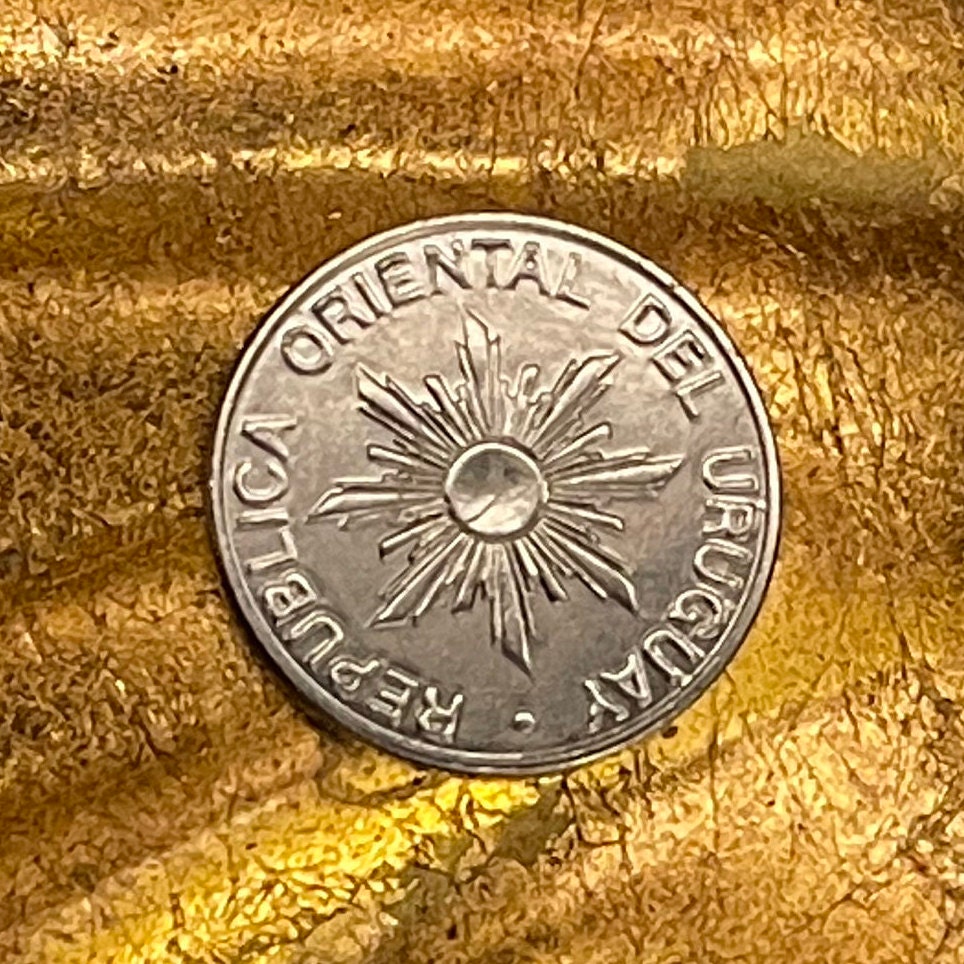elemintalshop
Sun of May 5 Pesos Uruguay Authentic Coin Money for Jewelry and Craft Making (Sol Invictus) (Inti) (Inca God)
Sun of May 5 Pesos Uruguay Authentic Coin Money for Jewelry and Craft Making (Sol Invictus) (Inti) (Inca God)
Couldn't load pickup availability
Sun of May 5 Pesos Uruguay Authentic Coin Money for Jewelry and Craft Making
Obverse: Radiant Sun of May (without the usual face); surrounded by country name.
Lettering: REPUBLICA ORIENTAL DEL URUGUAY
Reverse: Denomination, value and date on center, with 2 branches, one of olives the other of laurel, tied on bottom with a bow.
Lettering: N$ 5
1989
Features
Issuer Uruguay
Period Oriental Republic of Uruguay (1825-date)
Type Standard circulation coin
Year 1989
Value 5 Nuevos Pesos (5 UYN)
Currency Nuevo peso (1975-1993)
Composition Stainless steel
Weight 1.4 g
Diameter 15.5 mm
Thickness 1 mm
Shape Round
Technique Milled
Orientation Medal alignment ↑↑
Demonetized 31 August 1995
Number N# 5307
References KM# 92, Schön# 77
Wikipedia:
The Sun of May (Spanish: Sol de Mayo) is a national emblem of Argentina and Uruguay, and appears on the flags of both countries.
According to Diego Abad de Santillán, the Sun of May represents Inti, the Incan god of the sun.
The Sun of May is also connected to Sol Invictus ("The Unconquered Sun"), a Roman god identified with the Sun (the main solar deity in the ancient Roman religion). This links it to the god Mitra Sol Invictus, a solar god whose worship the Roman emperor Aurelian made official throughout the Roman Empire.
The specification "of May" is a reference to the May Revolution which took place in the week from 18 to 25 May 1810, which marked the beginning of the independence from the Spanish Empire for the countries that were then part of the Viceroyalty of the Río de la Plata. A legend claims that as the new government was proclaimed, the sun broke through the clouds, which was seen as a good omen.
Variations
In the flag of Argentina, the Sun of May is the radiant golden yellow sun bearing the human face and thirty-two rays that alternate between sixteen straight and sixteen wavy.
In the flag of Uruguay, the Sun of May is the golden yellow sun bearing the human face and sixteen triangular rays that alternate between eight straight and eight wavy.
Inspired by the Latin American wars of independence, the Philippines which was a fellow former Spanish colony also adopted the Sun of May as a revolutionary banner.
The Sun of May is found on the official logo of the Cypriot House of Representatives.
In popular culture it is also used by Nilfgaard in The Witcher fantasy series, the Evil Sunz faction of Orks in Warhammer 40,000, the Hexoatl Lizardmen of Lord Mazdamundi in Total War: Warhammer II, Apollo in Yu-Gi-Oh! Arc-V, Michael Demiurgos in DC Comics, the Helios Radiant Set DLC of Assassin's Creed Odyssey and the Changes video of American rock band Godsmack.
Description
The sun, called the Sun of May, is a replica of an engraving on the first Argentine coin, approved in 1813 by the Constituent Assembly, whose value was eight escudos (one Spanish dollar).
In form, it is similar to—and may be partially derived from—the sun in splendour, which is common in European heraldry. This, too, is usually depicted with a face, and with alternating straight and wavy rays (representing light and heat respectively), though it normally has only sixteen rays.
A 1978 law describing the official ceremonial flag of Argentina specifies that the sun must be golden yellow in color (amarillo oro), have an inner diameter of 10 cm, and an outer diameter of 25 cm (the diameter of the sun equals 5⁄6 the height of the white stripe, and the sun's face is 2⁄5 of its height), must feature 32 rays (16 undulated and 16 straight in alternation),[3] and must be embroidered in the official ceremonial flag.
********
According to Diego Abad de Santillán, a leading figure in the Spanish and Argentine anarchist movements, the Sun of May represents Inti, the Incan God of the Sun. Inti was created from an island on Lake Titicaca by the almighty Incan deity Viracocha, according to Incan mythology. Incan rulers would claim relation or communication with Inti to obtain power as intermediaries between humans and the gods. Some even wore costumes of sheet-gold to represent their divine heritage and connection to Inti.
The ‘House of the Sun’, or Coricancha Temple, was dedicated to Inti’s worship. Intihuatana, or “the place when the sun gets tied”, were sacred sites where sun ceremonies would often take place. One of the most famous examples was Machu Picchu: Ancient Incans used it as a clock to measure the solstices. Incan rulers also took annual pilgrimages to Lake Titicaca’s The Island of the Sun.
Magical imbuements: Life, fatherhood, warmth, courage, independence, victory, glory
Share

















